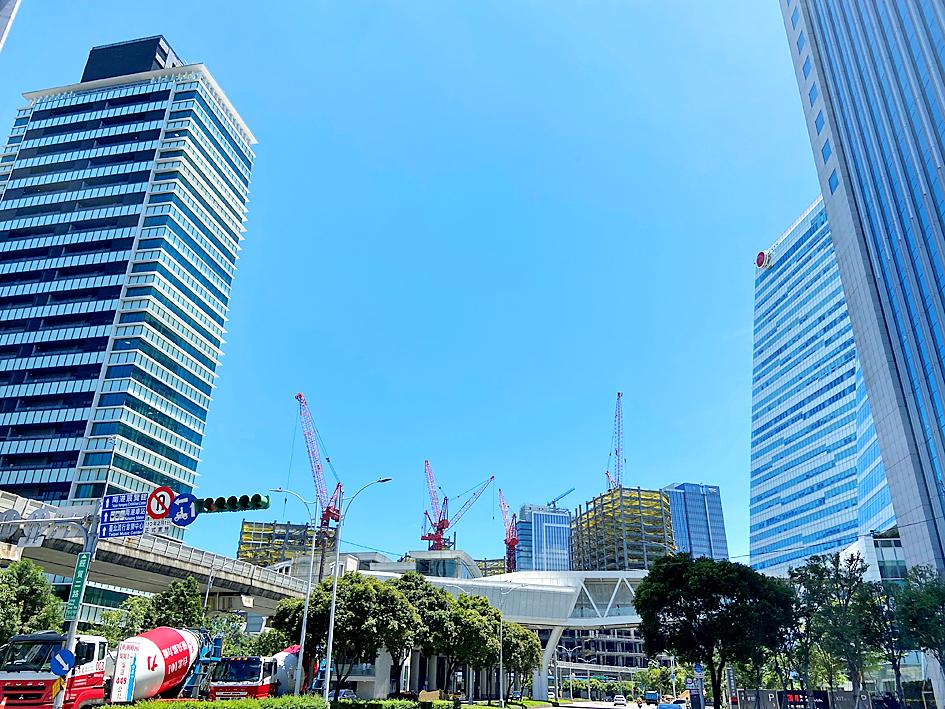Huaku Development Co (華固建設) yesterday won the auction for an 875 ping (2,887.5m2) plot in Taipei’s Nangang District (南港) at NT$4.49 billion (US$161.67 million).
The Taipei-based developer is to pay an 80 percent premium on the asking price for the plot near MRT Kunyang Station.
The price of NT$5.13 million per ping is a record for the area, as the district evolves into a first-tier area for property development.

Photo: Hsu Yi-ping, Taipei Times
Sinyi Realty Inc (信義房屋) head researcher Tseng Ching-der (曾敬德) said that the deal showed that Huaku is upbeat about property demand and prices in the district.
Major builders have in the past few years opened offices in Nangang, which has benefitted from urban renewal efforts and corporate migration from Taipei’s prime Xinyi District (信義), Tseng said.
The plot is near the site where Goldsun Group (國產實業集團) is planning to build its new headquarters and a planned high-rise office building by Ruentex Development Co (潤泰新).
Huaku is expected to ask NT$1.1 million per ping amid favorable development terms, real-estate consultancy REPro Knight Frank said.
The plot might be turned into a mixed-use complex with residential and commercial spaces, the consultancy said, adding that upscale office spaces in Taipei cost NT$4,000 rent per ping per month.

China’s Huawei Technologies Co (華為) plans to start mass-producing its most advanced artificial intelligence (AI) chip in the first quarter of next year, even as it struggles to make enough chips due to US restrictions, two people familiar with the matter said. The telecoms conglomerate has sent samples of the Ascend 910C — its newest chip, meant to rival those made by US chipmaker Nvidia Corp — to some technology firms and started taking orders, the sources told Reuters. The 910C is being made by top Chinese contract chipmaker Semiconductor Manufacturing International Corp (SMIC, 中芯) on its N+2 process, but a lack

NVIDIA PLATFORM: Hon Hai’s Mexican facility is to begin production early next year and a Taiwan site is to enter production next month, Nvidia wrote on its blog Hon Hai Precision Industry Co (鴻海精密), the world’s biggest electronics manufacturer, yesterday said it is expanding production capacity of artificial intelligence (AI) servers based on Nvidia Corp’s Blackwell chips in Taiwan, the US and Mexico to cope with rising demand. Hon Hai’s new AI-enabled factories are to use Nvidia’s Omnivores platform to create 3D digital twins to plan and simulate automated production lines at a factory in Hsinchu, the company said in a statement. Nvidia’s Omnivores platform is for developing industrial AI simulation applications and helps bring facilities online faster. Hon Hai’s Mexican facility is to begin production early next year and the

Who would not want a social media audience that grows without new content? During the three years she paused production of her short do-it-yourself (DIY) farmer’s lifestyle videos, Chinese vlogger Li Ziqi (李子柒), 34, has seen her YouTube subscribers increase to 20.2 million from about 14 million. While YouTube is banned in China, her fan base there — although not the size of YouTube’s MrBeast, who has 330 million subscribers — is close to 100 million across the country’s social media platforms Douyin (抖音), Sina Weibo (新浪微博) and Xiaohongshu (小紅書). When Li finally released new videos last week — ending what has

AVIATION BOOM: CAL is to renew its passenger and cargo fleets starting next year on record profits as aviation continues to return to pre-pandemic levels China Airlines Ltd (CAL, 中華航空) yesterday said it is optimistic about next year’s business outlook, as the airline continues to renew its fleet on expectations that global passenger traffic would maintain steady growth and air cargo demand would remain strong. From next year to 2028, the airline is to welcome a new Boeing Co 787 fleet — 18 787-9 and six 787-10 passenger aircraft — to cover regional and medium to long-haul destinations, CAL chairman Hsieh Shih-chien (謝世謙) said at an investors’ conference in Taipei. The airline would also continue to introduce Airbus SE 321neo passenger planes and Boeing 777F cargo jets,